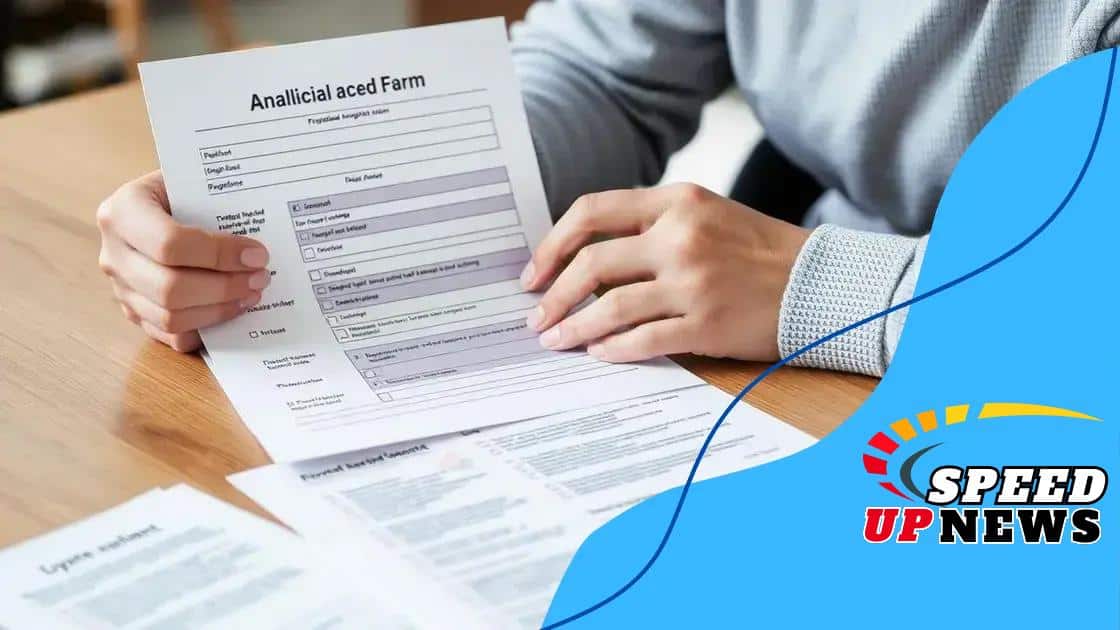Emergency financial relief during natural disasters

Emergency financial relief during natural disasters includes various types of assistance from federal agencies like FEMA, local governments, and nonprofit organizations, aimed at supporting affected individuals and families in their recovery efforts.
Emergency financial relief during natural disasters offers crucial support to those affected. Have you ever wondered how you could get help when disaster strikes? In this article, we will explore the different types of assistance available and how to access them.
Understanding emergency financial relief
Understanding emergency financial relief is essential for those facing the aftermath of natural disasters. This relief can help individuals and families recover quickly and regain stability. Knowing what options are available can make a significant difference in a crisis.
What is Emergency Financial Relief?
Emergency financial relief refers to various forms of assistance given to individuals affected by emergencies, primarily due to natural disasters. This relief can come from government agencies, non-profit organizations, and community groups.
Types of Relief Available
Each program may have specific criteria and eligibility requirements. Here are some common types of relief:
- Federal Assistance: Grants and low-interest loans provided by the Federal Emergency Management Agency (FEMA).
- Local Government Aid: Financial support from city or county programs to help residents recover.
- Nonprofit Organizations: Charitable groups that offer direct financial assistance or resources for recovery.
Emergency financial relief can also include help with housing, food, and medical expenses. Each form of assistance has guidelines, which can change based on the disaster’s scale and the resources available.
Understanding how to apply for assistance is critical. Many organizations provide online resources and guidance on their websites. By familiarizing yourself with these options, you can act quickly when help is needed.
Applying for Assistance
To benefit from emergency financial relief, it’s important to follow the correct application process. Generally, you’ll need to gather necessary documents such as identification, proof of residence, and any loss verification that might be required. This information helps expedite the assistance process.
In addition, staying informed about deadlines and requirements is crucial. Programs may have time-sensitive application windows, so checking regularly can ensure you do not miss out on support. Many applicants find success in reaching out to local agencies for additional help.
As you navigate the recovery process, remember that emergency financial relief can provide a lifeline, restoring hope and stability in difficult times. Utilizing available resources effectively will enable quicker recovery.
Types of financial relief available
When it comes to financial relief after a disaster, understanding the types available can significantly impact recovery. Each type serves different needs and situations, so it’s crucial to know what options you qualify for.
Federal Assistance Programs
The government provides several federal programs designed to help individuals impacted by natural disasters. One prominent source is the Federal Emergency Management Agency (FEMA). These programs often include:
- Grants: Direct financial assistance that does not need to be repaid.
- Low-interest loans: Financial aid that can help cover repairs and rebuilding costs.
- Individual Assistance: Support for housing, personal property, and other related expenses.
These programs are essential for rebuilding lives and homes in the aftermath of a disaster.
State and Local Government Relief
In addition to federal aid, state and local governments often offer relief programs tailored to their communities. These can include:
- Emergency funds: Allocated funds to help residents in immediate distress.
- Community assistance: Local agencies providing food, shelter, and additional support.
- Housing assistance: Programs that help with rent, mortgage, or temporary housing.
It is beneficial to check with local officials or community organizations to discover the specific aid available in your area.
Apart from government efforts, nonprofit organizations play a vital role in providing assistance. These organizations can offer resources such as:
- Direct financial support: Grants or donations to help with expenses.
- Resource distribution: Items like clothes, food, and household supplies.
- Emotional support: Counseling services to help individuals cope with trauma.
Understanding these resources will help you navigate the recovery landscape. Each type of financial relief has specific application processes and eligibility criteria, which can vary widely.
During crises, getting the right information quickly can change the outcome for those affected. Knowing where to apply and what to expect will lead to a more effective recovery.
How to apply for assistance

Applying for financial assistance after a disaster can be an overwhelming process. Knowing the steps to take can help make the experience smoother. Understanding how to gather necessary information is essential for a successful application.
Gather Required Documents
Before you start the application, it’s vital to collect all required documents. This includes:
- Identification: A government-issued ID or driver’s license.
- Proof of residence: Utility bills or rental agreements showing your address.
- Damage verification: Pictures or reports detailing your losses.
Having these documents readily available can speed up the process significantly.
Accessing Application Forms
Next, to apply for assistance, you need to access the relevant forms. This can be done online or by visiting local offices. Many agencies provide:
- Online applications: These are often the fastest way to apply.
- In-person assistance: Available for those who prefer face-to-face help.
- Hotlines: Many organizations offer hotlines to guide applicants.
Choosing the best method for you can make the application process easier.
Once you have filled out the forms, it is essential to review your application thoroughly. Double-check all information to avoid confusion or delays. If possible, have someone else review your application as well to catch errors you might have missed.
After submitting, keep track of your application status. Many agencies provide ways to check this online or by phone, ensuring you stay informed throughout the process.
Remember, applying for financial assistance can take time. Do not hesitate to reach out for help or clarification if you encounter difficulties along the way. Understanding the steps ensures you stay organized and focused during a challenging time.
Important resources for disaster relief
When dealing with the aftermath of a disaster, knowing where to find important resources for disaster relief is crucial. These resources can provide essential support, assisting individuals and families in their recovery efforts. Various organizations and agencies offer help.
Government Agencies
Federal and state agencies play a vital role in providing disaster relief. The Federal Emergency Management Agency (FEMA) is one of the most significant resources. They offer:
- Financial assistance: This helps with housing and recovery costs.
- Temporary housing: Resources such as shelters are available for those displaced.
- Disaster recovery centers: These centers provide information and assistance to affected individuals.
In addition to FEMA, your local government may have programs to assist residents. Checking with local offices is essential for tailored support specific to your community.
Nonprofit Organizations
Many nonprofit organizations are dedicated to disaster relief. These groups offer a variety of services, including:
- Immediate aid: Food, water, and clothing distributions are common.
- Mental health support: Counseling services help individuals cope with trauma.
- Long-term recovery programs: Ongoing assistance for rebuilding efforts.
Organizations like the Red Cross and local charities often mobilize quickly after disasters to provide necessary assistance.
Community resources are also invaluable in disaster situations. Local faith-based organizations and community groups often hold drives to collect donations for those impacted. Activities such as:
- Fundraisers: Events to raise money for affected families.
- Supply collections: Gathering items needed by those impacted.
- Volunteer opportunities: Community members can help with recovery efforts.
Utilizing these resources can significantly improve recovery efforts. Remember to spread the word about available assistance to ensure everyone can benefit from the help.
Common challenges faced during applications
When applying for financial relief, many individuals encounter challenges that can complicate the process. Recognizing these common issues can help applicants prepare and navigate the application smoothly.
Missing Documentation
One of the biggest hurdles is lacking necessary documentation. Many applications require proof of identity, residence, and damages. Without these documents, it may be impossible to proceed. Common documents needed include:
- Identification: A driver’s license or government-issued ID.
- Utility bills: Proof of residency to show where you lived.
- Photos of damages: Evidence to support your claim.
Gathering these items ahead of time can help prevent delays.
Understanding Eligibility Criteria
Eligibility requirements can be complex and vary between programs. Many applicants find it challenging to determine if they qualify for assistance. Programs may consider factors such as:
- Income level: Some programs have income thresholds.
- Type of disaster: Not all resources apply to every situation.
- Residency status: Some resources are only available to local residents.
Carefully reviewing the requirements can ensure individuals apply for the correct assistance.
Another challenge is the application process itself. Many applicants feel overwhelmed by the paperwork involved. It requires careful attention to detail and can take time. If forms are not filled out correctly, they may be rejected or delayed. To avoid this:
- Read instructions carefully: Ensure you understand the requirements for each form.
- Seek help: Community organizations often help applicants complete forms accurately.
- Follow up: After submitting, check back to confirm receipt and status.
Communicating with assistance agencies can also be difficult. Long wait times and multiple contacts may frustrate applicants. Staying patient and organized is key. Keeping records of all correspondence can prove beneficial.
Knowing these challenges can empower applicants. Understanding the typical obstacles and preparing can help streamline the process of applying for financial relief.
In summary, understanding the process of applying for financial relief during natural disasters is critical for those affected. By knowing the types of relief available, how to apply, and recognizing common challenges, individuals can navigate their recovery journey more effectively. Staying organized and informed ensures that you can access the necessary support when you need it most. Remember, help is available, and taking these steps can lead to a quicker recovery.
FAQ – Frequently Asked Questions about Emergency Financial Relief
What types of relief are available after a natural disaster?
There are several types of relief, including federal assistance from FEMA, local government aid, and support from nonprofit organizations.
How can I apply for financial assistance?
To apply, gather necessary documents like ID and proof of residence, then access application forms through online sites or local offices.
What common challenges do applicants face?
Common challenges include missing documentation, understanding eligibility criteria, and navigating the application process.
Where can I find additional resources for disaster relief?
Important resources can be found through government agencies, nonprofit organizations, and community groups that provide support and aid.





